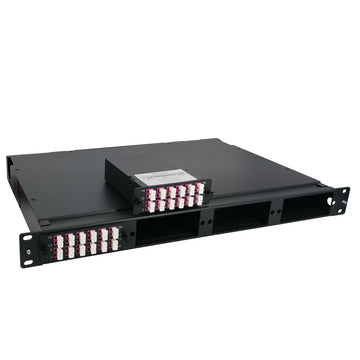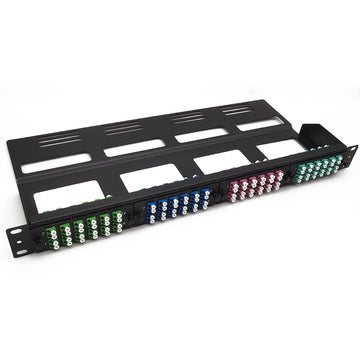Optical Amplifier is a Key Technology for Restoring Signals
Introduction To Optical Amplifiers
Optical amplifiers, as the key technology for optical communication networks, have made it possible to transmit many terabits of data over distances from a few hundred kilometers and up to transoceanic distances with wavelength-division multiplexing (WDM) technology, which allows the transmission of multiple channels over the same fiber. The transmission distance of any optical fiber communication system is eventually limited by fiber losses. Optical amplifiers overcome the loss limitation by amplifying the entire WDM signals in strength by several orders of magnitude without requiring conversion of each channel to the electric domain, thus permitting a dramatic increase in capacity of the transmission system and providing the data capacity required for current and future communication networks. The purpose of this passage is to provide an overview of optical amplifiers.
Application of Optical Amplifier
Optical amplifiers can be employed in 3 ways between transmitter and receiver in order to achieve desired signal amplification.
Booster Amplifier: A booster or power amplifier is placed immediately after the transmission unit. It enhances the level of the signal before the signal is provided to the optical link for transmission. This is done in order to accomplish long-distance transmission.power amplifier configuration for optical amplifier
Inline Amplifier: When we talk about inline amplifier unit then it is placed at some distances in the fiber link itself in order to restore the original message signal from the distorted one. As it offers medium gain then it becomes necessary to place multiple in-line amplifiers in case of long-distance transmission.
Pre-amplifier: A pre-amplifier is usually placed at the receiving end of the system. The transmitted signal must be of such level that it can be easily detected by the receiver. A signal that has transmitted a very long distance gets highly attenuated despite several amplifications during its journey. This causes difficulty for the receiver to detect the respective signal. Thus, a preamplifier, having high gain is amplified by a preamplifier just before entering the receiver unit.
It is to be noted here that the gain of an amplifier depends on the intensity and wavelength of the transmitted light signal.
Classification of Optical Amplifier
There are three most important types of optical amplifiers including erbium-doped fiber amplifier(EDFA), semiconductor optical amplifier (SOA) and Raman amplifier. Here will introduce them briefly.
Erbium-Doped Fiber Amplifier (EDFA): As the first optical amplifier widely used in optical communications systems, EDFA has resulted in a dramatic growth in transmission capacity with the deployment of WDM systems. It is an optical or IR repeater that amplifies a modulated laser beam directly without optical to electrical conversion. It uses a short length of optical fiber doped with the rare-earth element erbium. The signals-carrying laser beams are usually at IR wavelengths with application of external energy. It has low noise and capable of amplifying many wavelengths simultaneously, which is an excellent choice in optical communications.

Semiconductor Optical Amplifier (SOA): It is an optical amplifier which uses a semiconductor to provide the gain medium. This material can be tailored to provide optical amplification at wavelengths near 1.3 µm or near 1.5 µm which are important wavelengths for optical communications. It makes fewer noises than EDFA and generates less handle power. But it is more suitable to be used in networks where the best performance is not required for it is less expensive.
![]()
SOAs operate in a similar way to standard semiconductor lasers (without optical feedback which causes lasing), and are packaged in small semiconductor “butterfly” packages. Unlike other optical amplifiers, they are pumped electronically and a separate pump laser is not required. SOAs are less expensive and therefore suitable for using in local networks where best performance is not required but cost is an important factor.Despite their small size and potentially low cost due to mass production, SOAs suffer from a number of drawbacks which make them unsuitable for most applications. In particular, they provide relatively low gain, have a low saturated output power and relatively high noise factor (NF). These drawbacks makes SOAs unsuitable for multichannel application but fit for some single channel which don’t require high gain and high output power.
Raman Amplifier (RA): It is an optical amplifier based on Raman gain created by Raman scattering, which works entirely differently from EDFA or SOA. Raman optical amplifier have two key elements: the pump laser and the directional coupler. The pump laser has a wavelength of 90 nm to 1500 nm. The circulator provides a convenient means of injecting light backwards in to the transmission path with minimal optical loss. Raman amplification occurs throughout the length of transmission fiber, which makes Raman amplifier known as distributed amplifier. Raman amplifiers are often used together with EDFAs to offer ultra-low NF combined amplifiers, which are useful in applications such as long links without inline amplifiers, ultra-long links expanding thousands of kilometers, or very high bit-rate links.
Conclusion
Optical amplifiers are the critical technology for the optical communication networks, enabling the transmission of many terabits of data over distances from a few hundred kilometers and up to thousands of kilometers by overcoming the fiber loss limitation. The optical amplifier can help to amplifier the optical power during long haul transmission to ensure that the receiver can detect the optical signal without error. Through concretely introducing optical amplifiers above, I hope this passage can help you get better understanding of optical amplifiers. The gain of these amplifiers should be carefully calculated during practical use. Kindly visit LightOptics for more details.












